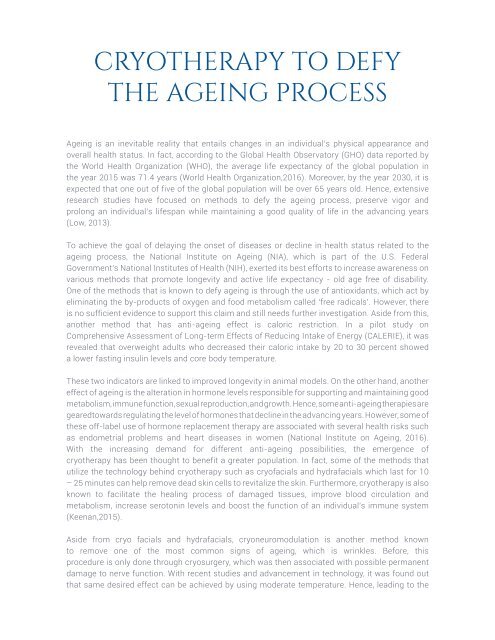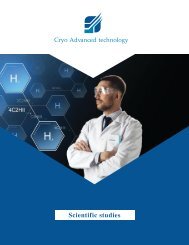BROCHURE Scientific-Studies-Cryotherapy
Create successful ePaper yourself
Turn your PDF publications into a flip-book with our unique Google optimized e-Paper software.
CRYOTHERAPY TO DEFY<br />
THE AGEING PROCESS<br />
Ageing is an inevitable reality that entails changes in an individual’s physical appearance and<br />
overall health status. In fact, according to the Global Health Observatory (GHO) data reported by<br />
the World Health Organization (WHO), the average life expectancy of the global population in<br />
the year 2015 was 71.4 years (World Health Organization,2016). Moreover, by the year 2030, it is<br />
expected that one out of five of the global population will be over 65 years old. Hence, extensive<br />
research studies have focused on methods to defy the ageing process, preserve vigor and<br />
prolong an individual’s lifespan while maintaining a good quality of life in the advancing years<br />
(Low, 2013).<br />
To achieve the goal of delaying the onset of diseases or decline in health status related to the<br />
ageing process, the National Institute on Ageing (NIA), which is part of the U.S. Federal<br />
Government’s National Institutes of Health (NIH), exerted its best efforts to increase awareness on<br />
various methods that promote longevity and active life expectancy - old age free of disability.<br />
One of the methods that is known to defy ageing is through the use of antioxidants, which act by<br />
eliminating the by-products of oxygen and food metabolism called ‘free radicals’. However, there<br />
is no sufficient evidence to support this claim and still needs further investigation. Aside from this,<br />
another method that has anti-ageing effect is caloric restriction. In a pilot study on<br />
Comprehensive Assessment of Long-term Effects of Reducing Intake of Energy (CALERIE), it was<br />
revealed that overweight adults who decreased their caloric intake by 20 to 30 percent showed<br />
a lower fasting insulin levels and core body temperature.<br />
These two indicators are linked to improved longevity in animal models. On the other hand, another<br />
effect of ageing is the alteration in hormone levels responsible for supporting and maintaining good<br />
metabolism, immune function, sexual reproduction, and growth. Hence, some anti-ageing therapies are<br />
gearedtowards regulating the level of hormones that decline in the advancing years. However, some of<br />
these off-label use of hormone replacement therapy are associated with several health risks such<br />
as endometrial problems and heart diseases in women (National Institute on Ageing, 2016).<br />
With the increasing demand for different anti-ageing possibilities, the emergence of<br />
cryotherapy has been thought to benefit a greater population. In fact, some of the methods that<br />
utilize the technology behind cryotherapy such as cryofacials and hydrafacials which last for 10<br />
– 25 minutes can help remove dead skin cells to revitalize the skin. Furthermore, cryotherapy is also<br />
known to facilitate the healing process of damaged tissues, improve blood circulation and<br />
metabolism, increase serotonin levels and boost the function of an individual’s immune system<br />
(Keenan,2015).<br />
Aside from cryo facials and hydrafacials, cryoneuromodulation is another method known<br />
to remove one of the most common signs of ageing, which is wrinkles. Before, this<br />
procedure is only done through cryosurgery, which was then associated with possible permanent<br />
damage to nerve function. With recent studies and advancement in technology, it was found out<br />
that same desired effect can be achieved by using moderate temperature. Hence, leading to the



